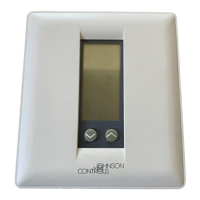2
T500 Series Non-Programmable Thermostats Product/Technical Bulletin
I
ntroduction
The T500 thermostats use an adaptive control
routine, based on fuzzy logic, to determine the
heating or cooling load of the controlled space.
The routine calculates load by evaluating recent
room conditions, and room reactions to heating and
cooling. This load is used to determine the cycle rate
of the equipment, giving optimal control of the space.
114.3
(4-1/2)
101.6
(4)
22.2
(7/8)
Dmnsn
Figure 2: T500 Dimensions, mm (in.)
S
upplies Needed
•
drill
•
4.7 mm (3/16 in.) drill bit
•
3 mm (1/8 in.) flat-blade screwdriver
•
hammer
•
marking pencil
•
wire stripper
L
ocation Considerations
Locate T500 thermostats as follows:
•
on a partitioning interior wall, and approximately
1.5 m (5 ft) above the floor in a location of
average temperature
•
away from direct sunlight or radiant heat, outside
walls or behind doors, air discharge grills,
stairwells, or outside doors
•
away from steam or water pipes, warm air
stacks, unheated/uncooled areas, or sources of
electrical interference
!
CAUTION:
Shock Hazard.
Disconnect power supply
before wiring connections are
made to prevent electrical
shock or possible damage to
the equipment.
I
nstallation and Wiring
Note: When replacing an existing thermostat,
remove and use wire tags to identify terminal
designations.
To install and wire the thermostat:
1. Lift the thermostat cover and insert a small coin
into the slot located in the bottom center of the
thermostat case and twist 1/4 turn. Grasp the
base from the bottom two corners and separate
from the thermostat. (See Figure 3.)
2. Swing the thermostat out from the bottom, and
lift up and out of the base. Place the rectangular
opening in the base over the equipment control
wires protruding from the wall and, using the
base as a template, mark the location of the two
mounting holes. No leveling is required.
3. Use the supplied anchors and screws for
mounting on drywall or plaster. Drill two 4.7 mm
(3/16 in.) holes at the marked locations, and tap
nylon anchors flush to wall surface and fasten.
(See Figure 4.)
4. Connect the wires from the existing system to
the thermostat terminals according to the wiring
designations in Table 4, Table 5, or Table 6.
Push extra wire back into the wall. Wires must
be flush to the plastic base. Plug hole with a
fireproof material to prevent drafts from affecting
the ambient temperature readings.

